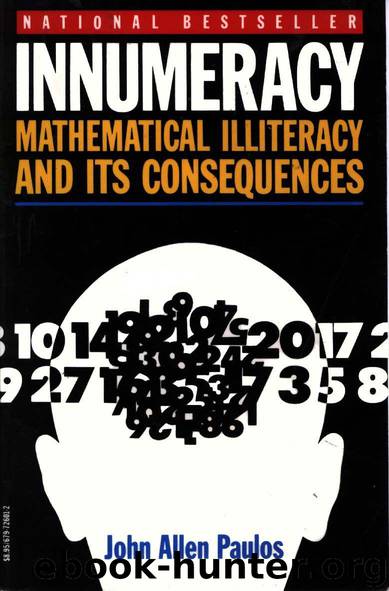Innumeracy: Mathematical Illiteracy And Its Consequences by John Paulos

Author:John Paulos
Language: eng
Format: mobi
Tags: sci_math
Published: 2010-10-25T22:00:00+00:00
LOGIC AND PSEUDOSCIENCE
Since numbers and logic are inextricably intertwined both theoretically and in the popular mind, it's perhaps not stretching matters too far to describe faulty logic as a kind of innumeracy. This assumption has in fact been implicit throughout much of this chapter. Let me end, then, with a couple of additional bad inferences which are further suggestive of the role that innumeracy-in the guise of fallacious logic-plays in pseudoscience.
Confusing a conditional statement-if A, then B-with its converse-if B, then A-is a very common mistake. A slightly unusual version of it occurs when people reason that if X cures Y, then lack of X must cause Y. If the drug dopamine, e.g., brings about a decrease in the tremors of Parkinson's disease, then lack of dopamine must cause tremors. If some other drug relieves the symptoms of schizophrenia, then an excess of it must cause schizophrenia. One is not as likely to make this mistake when the situation is more familiar. Not too many people believe that since aspirin cures headaches, lack of aspirin in the bloodstream must cause them.
From a jar of fleas before him, the celebrated experimenter Van Dumholtz carefully removes a single flea, gently pulls off its back legs, and in a loud voice commands it to jump. He notes that it doesn't move and tries the same thing with a different flea. When he's finished, he compiles statistics and concludes confidently that a flea's ears are in its back legs. Absurd perhaps, but variants of this explanation in less transparent contexts might carry considerable force for people with strong enough preconceptions. Is the explanation any more absurd than that accepted by those who believe the woman who maintains that she is the channel through which a 35,000-year-old man expresses himself? Is it more strained than claims that the skepticism of onlookers systematically prevents the occurrence of certain paranormal phenomena?
What's wrong with the following not quite impeccable logic? We know that 36 inches = 1 yard. Therefore, 9 inches = 1/4 of a yard. Since the square root of 9 is 3 and the square root of 1/4 is 1/2, we conclude that 3 inches = 1/2 yard!
Disproving a claim that something exists is often quite difficult, and this difficulty is often mistaken for evidence that the claim is true. Pat Robertson, the former television evangelist and Presidential candidate, maintained recently that he couldn't prove that there weren't Soviet missile sites in Cuba and therefore there might be. He's right, of course, but neither can I prove that Big Foot doesn't own a small plot of land outside Havana. New Agers make all sorts of existence assertions: that ESP exists, that there have been instances of spoon bending, that spirits abound, that there are aliens among us, etc. Presented as I periodically am with these and other fantastical claims, I sometimes feel a little like a formally dressed teetotaler at a drunken orgy for reiterating that not being able to conclusively refute the claims does not constitute evidence for them.
Download
This site does not store any files on its server. We only index and link to content provided by other sites. Please contact the content providers to delete copyright contents if any and email us, we'll remove relevant links or contents immediately.
| Biomathematics | Differential Equations |
| Game Theory | Graph Theory |
| Linear Programming | Probability & Statistics |
| Statistics | Stochastic Modeling |
| Vector Analysis |
Modelling of Convective Heat and Mass Transfer in Rotating Flows by Igor V. Shevchuk(6406)
Weapons of Math Destruction by Cathy O'Neil(6205)
Factfulness: Ten Reasons We're Wrong About the World – and Why Things Are Better Than You Think by Hans Rosling(4710)
A Mind For Numbers: How to Excel at Math and Science (Even If You Flunked Algebra) by Barbara Oakley(3248)
Descartes' Error by Antonio Damasio(3247)
Factfulness_Ten Reasons We're Wrong About the World_and Why Things Are Better Than You Think by Hans Rosling(3216)
TCP IP by Todd Lammle(3153)
Fooled by Randomness: The Hidden Role of Chance in Life and in the Markets by Nassim Nicholas Taleb(3077)
Applied Predictive Modeling by Max Kuhn & Kjell Johnson(3038)
The Tyranny of Metrics by Jerry Z. Muller(3025)
The Book of Numbers by Peter Bentley(2927)
The Great Unknown by Marcus du Sautoy(2661)
Once Upon an Algorithm by Martin Erwig(2619)
Easy Algebra Step-by-Step by Sandra Luna McCune(2603)
Lady Luck by Kristen Ashley(2552)
Police Exams Prep 2018-2019 by Kaplan Test Prep(2513)
Practical Guide To Principal Component Methods in R (Multivariate Analysis Book 2) by Alboukadel Kassambara(2512)
All Things Reconsidered by Bill Thompson III(2369)
Linear Time-Invariant Systems, Behaviors and Modules by Ulrich Oberst & Martin Scheicher & Ingrid Scheicher(2346)
